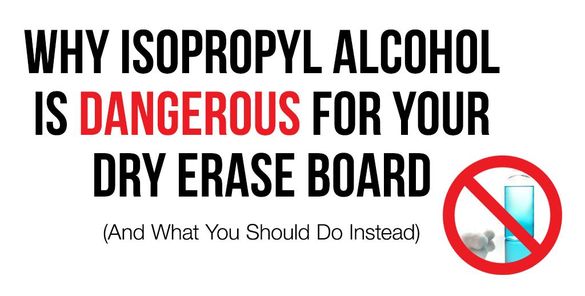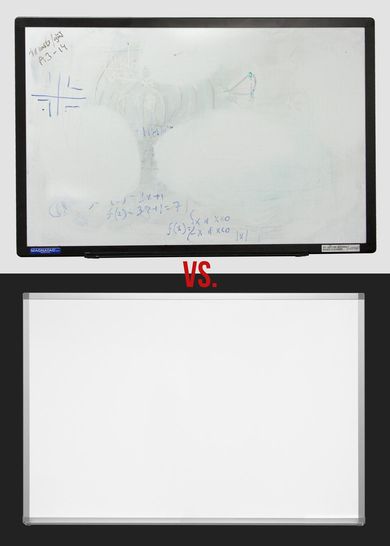Magnatag InSight
The whiteboard and how it helps us brainstorm, innovate, motivate and create
RECENT BLOG POSTS
- Full‑Wall Whiteboard Panels vs Paint: Performance, Cost, and Longevity Compared
- The Definitive Guide to Creating High‑Quality Branded Whiteboards with Magnatag
- Glass vs. Porcelain: Which Whiteboard Surface Fits Modern Offices Best?
- The Definitive Guide to Choosing Durable Whiteboard Walls for Modern Offices
- Why 2025 Is the Year to Upgrade Your Office Magnetic Whiteboard
- 7 Steps to Create a Visual Workflow Board for Teams
CATEGORIES

Why isopropyl Alcohol is Dangerous For Your Dry Erase Board
Wed Nov 29 2017By: Mike P
If you do a bit of research on the best ways to clean a whiteboard, chances are the first recommendation you’ll find contains alcohol at the top of the list. There’s a common misconception out there that it’s okay to clean your whiteboard with rubbing alcohol; we’re here to tell you that is not entirely true. We’ll be the first to admit that isopropyl alcohol works as a tremendous cleaning agent, but when it comes to maintaining the quality of your dry erase board, it’s the worst solution imaginable.
To understand why this is the case, we first have to take a look at how dry erase boards work. Dry erase markers are made with an oily silicone polymer, which is commonly referred to as a release agent, that prevents ink from sinking into the surface of the board. With colored-pigments giving the ink color, and the solvent dissolving both the pigments and the polymer, the three ingredients are combined and stored in a polyester reservoir that helps contain the ink inside the marker’s casing. When the ink makes contact with the dry erase surface, the solvent evaporates leaving behind the pigment and the polymer. At this point, the pigment and the polymer are essentially two separate layers, with the pigment sitting on top of the polymer. When it comes time to erase ink, the pigment comes off while the polymer is left behind.
Now dry erase boards, in particular, are defined as non-porous, meaning ink cannot directly penetrate the surface itself. The exact component that makes whiteboards non-porous is an oily lubricant that makes up the outermost layer of the board. When the ink makes contact with the surface, the polymer instantly binds to the outermost layer, which allows only the colored-pigments to be erased. If the board’s lubricated surface begins to deteriorate, both the ink’s polymer and pigments will begin to soak into the board. This lack of lubrication is primary culprit for why older whiteboards occasionally leave behind ghost markings after they’ve been erased.
So what does all this have to do with alcohol? To put it simply, alcohol destroys the lubricating layer of your dry erase board. Yes, your whiteboard will look spotless, but after continued use, your whiteboard will eventually lose the ability to wipe clean. Take a look at the picture below: First, you'll find an image of a whiteboard we received a few months back from a customer that cited their whiteboard was no longer erasing. After a bit of research, we found that the whiteboard was being used in a healthcare facility that regularly used alcohol to sterilize and clean everything. Below this board is a whiteboard that has been cleaned with a whiteboard cleaning solution. Is there really anything else left to say?
Instead of using an alcohol-based solution to clean your board, we highly recommend using a whiteboard cleaner that doubles as a conditioner. These cleaning solutions ensure that your board stays free of any stains that are left behind, and that the board’s outermost layer remains oiled for long-term usage.
To understand why this is the case, we first have to take a look at how dry erase boards work. Dry erase markers are made with an oily silicone polymer, which is commonly referred to as a release agent, that prevents ink from sinking into the surface of the board. With colored-pigments giving the ink color, and the solvent dissolving both the pigments and the polymer, the three ingredients are combined and stored in a polyester reservoir that helps contain the ink inside the marker’s casing. When the ink makes contact with the dry erase surface, the solvent evaporates leaving behind the pigment and the polymer. At this point, the pigment and the polymer are essentially two separate layers, with the pigment sitting on top of the polymer. When it comes time to erase ink, the pigment comes off while the polymer is left behind.
Now dry erase boards, in particular, are defined as non-porous, meaning ink cannot directly penetrate the surface itself. The exact component that makes whiteboards non-porous is an oily lubricant that makes up the outermost layer of the board. When the ink makes contact with the surface, the polymer instantly binds to the outermost layer, which allows only the colored-pigments to be erased. If the board’s lubricated surface begins to deteriorate, both the ink’s polymer and pigments will begin to soak into the board. This lack of lubrication is primary culprit for why older whiteboards occasionally leave behind ghost markings after they’ve been erased.
So what does all this have to do with alcohol? To put it simply, alcohol destroys the lubricating layer of your dry erase board. Yes, your whiteboard will look spotless, but after continued use, your whiteboard will eventually lose the ability to wipe clean. Take a look at the picture below: First, you'll find an image of a whiteboard we received a few months back from a customer that cited their whiteboard was no longer erasing. After a bit of research, we found that the whiteboard was being used in a healthcare facility that regularly used alcohol to sterilize and clean everything. Below this board is a whiteboard that has been cleaned with a whiteboard cleaning solution. Is there really anything else left to say?

Instead of using an alcohol-based solution to clean your board, we highly recommend using a whiteboard cleaner that doubles as a conditioner. These cleaning solutions ensure that your board stays free of any stains that are left behind, and that the board’s outermost layer remains oiled for long-term usage.
Categories:Whiteboards For The Home